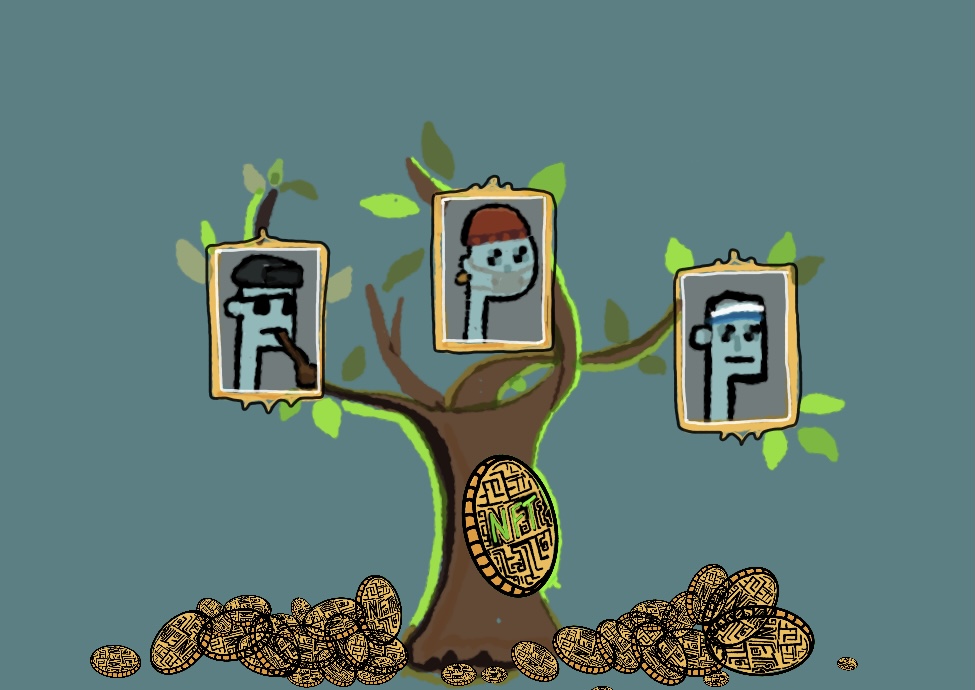From NFTs to Johnny Appleseed: Progress or purely status?
January 28, 2022
 This
piece represents the opinion of the author
.
This
piece represents the opinion of the author
.
 Aadhya Ramineni
Aadhya RamineniWalking around the Oakland Museum of California’s history gallery brought to my attention the idea of frontiers. I had recently read Michael Pollan’s “Botany of Desire,” and, in it, he describes the life and times of John Chapman (a.k.a. Johnny Appleseed). Chapman was a man of new frontiers and speculation. He’d leave apple seeds around the rivers he traveled on, speculating that in five or so years he would be able to return and sell the trees.
I didn’t think of Chapman at all in my visit to the museum, but was immersed in the common theme of speculation in the frontier known as California. California has repeatedly been a home ground to speculation: the Gold Rush in the 1840s-60s, the dot-com boom of the early 2000s, the Spanish hope to colonize and convert Native Americans. The Golden State has been a land of possibilities and promise (for some) throughout time.
The overarching connection between California and Chapman, in my eyes, was speculation. This seemingly weak link got me thinking of current speculative areas, namely cryptocurrency and the rising popularity of NFTs. I had been pretty skeptical about NFTs (non-fungible tokens) before doing research, and quite frankly, I stayed skeptical, if not anti-NFT, after doing research.
Mintable.app—one of the largest hubs for buying, selling and creating NFTs—defines non-fungible tokens as a “unique, individual token existing on a blockchain such as Ethereum.” I was still confused, but when I kept going down the rabbit hole of NFT research, I found that they are ultimately nothing but a belief.
A non-fungible token is really just metadata—data about data. When you think of an NFT, you likely think of a piece of art, a GIF or a short clip. That is not really the NFT itself, but a representation of one. In a sense, it is like a receipt. You are receiving the representation of your purchase, not necessarily the thing you (may have) thought you purchased. You are buying a position on a blockchain, not the thing representing the blockchain. It’s as if your dad decided to buy your mom a star for her birthday. Your mom or dad will obviously never have a star, but at least they have that certificate that says so.
Now you may be wondering how this ties into Chapman and California.
First, Chapman. We tend to tell fables of Johnny Appleseed being a benevolent tree-whisperer and man of nature. Perhaps this holds some truth, but the main reason Chapman grew apples was for alcohol. Frontiersmen had no reliable sources of alcohol yet, and they wanted one. John Chapman’s introduction of apple trees brought a consistent source of apples, and with that, cider. Chapman may have been an Earth-lover, but he also knew where the profit was.
Similarly, the speculative times of California have held lots of promise. But with the promise of grandeur, there has often been disappointment. Some may find success and strike rich, but most find a harsh reality of exploitation and insecurity. I am worried that, at its core, the new frontier of these digital enterprises is actually a new game of winners and losers, and the ‘Johnny Appleseeds’ of this digital world will be able to exploit profits out of people.
The success of NFTs lies in people buying into the belief that one day this artificial scarcity created in the blockchain will make NFTs valuable. As they currently stand, I don’t see long-term success for the model. NFTs hold some merits: they allow artists and creators to profit off their own creations, for instance. But much of the current market relies on exploiting the human psychology of belonging and exclusivity. NFTs are the modern man’s invention of status. Maybe they’ll succeed. I can tell you the time with a $20 digital watch, but someone with a Rolex can do the same and flaunt their status with it. I’d rather not succumb to this state of affairs, but perhaps speculators are right, and NFTs will be a vital component of currency and status. I hope not.

Comments
Before submitting a comment, please review our comment policy. Some key points from the policy: